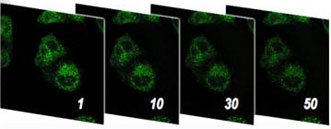NAGOYA, Japan, Oct. 27, 2015 — Photostable fluorescent dye for superresolution microscopy could serve as a powerful tool to visualize biological events and structural details in living cells for prolonged periods.
Researchers at Nagoya University have developed a fluorescent dye called C-Naphox optimized for stimulated emission depletion (STED) microscopy. Unlike other dyes that rapidly break down under the high-intensity illumination necessary for STED, C-Naphox showed virtually no degradation, even after prolonged exposure.
The researchers exposed C-Naphox and two other dyes commonly used in STED to light from a 300-W, 460-nm xenon lamp to test their relative photostability. C-Naphox remained 99 percent intact even after 12 hours of irradiation, whereas Alexa Fluor 488 remained 26 percent present after just two hours. The dye ATTO 488 survived mostly intact after two hours of irradiation but was reduced to 59 percent after 12 hours.

The photostable fluorescent dye C-Naphox maintains 83 percent of its luminance after exposure to 50 rounds stimulation emission depletion (STED) imaging. Courtesy of the Institute of Transformative Biomolecules, Nagoya University.
C-Naphox and Alexa Fluor 488 were also used to stain HeLa cells and exposed to repeated STED imaging conditions. Alexa Fluor 488-stained cells showed a decrease in fluorescence signal intensity after five recordings; the intensity of C-Naphox remained virtually unchanged under the same conditions, the researchers said.
C-Naphox can be synthesized rapidly and is air-stable for months at room temperatures. It's safe to use in live cells, exhibiting no significant toxicity at the micromolar concentrations usually required for cell staining.
The photoresistant dye may be useful in studying the formation of actin filaments in cells and other biological events, the researchers said.
The research was published in Angewandte Chemie International Edition (doi: 10.1002/anie.201507939).